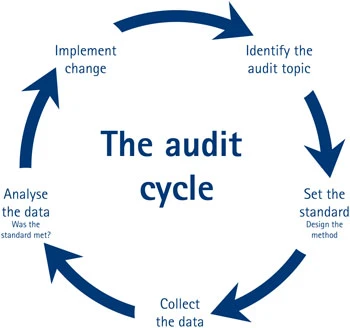What is a clinical audit in healthcare?
Clinical audits in healthcare are a way to ensure that the required standards of healthcare are being adhered to, and identify any areas that need improvement.
These can take the form of either a national clinical audit, which takes a look at healthcare as whole nationwide, or it can be more localised in trusts, looking at anywhere that healthcare is provided, like individual hospitals or doctors practises.
Using data collected over time, a clinical audit in healthcare will aim to measure the current patient care compared the required standards – and then set in place changes if improvement is needed.
The two main questions that a clinical audit hopes to answer are ‘is best practice being followed?’ and ‘what is happening to patients as a result?’
What are the benefits of a clinical audit?
Clinical audits in Healthcare are essential when it comes to identifying trends within healthcare as a whole. They can offer a framework which can be used for systematic improvement throughout the entire industry, based around the patterns and trends that emerge.
This is so important when it comes to identifying risks in the care sector, and can prevent major problems before they happen.
It can also be reassuring for an establishment to know exactly how they are performing in certain areas of their day-to-day running, and help them identify areas that they need to improve to offer a better service to their patients.
Which governing bodies oversee clinical audits in healthcare?
It is the responsibility of the Care Quality Commission (CQC) to monitor, inspect and regulate all manner of care services, from hospitals and GP surgeries, to care homes and community services. They, therefore, oversee all clinical audits in healthcare.
Who actually carries out the audits is slightly more complicated, and will depend on many different factors like where the audit is and what exactly is being audited. Organisations like The National Clinical Audit and Patient Outcomes Programme (NCAPOP) and National Quality Improvement and Clinical Audit Network (NQICAN) will both manage audits.
Ultimately, though, it is the responsibility of the CQC to ensure that patients are treated, cared for and supported to a high standard.
The clinical audit cycle
Clinical audits in healthcare are often described as a cylindrical process as they tend to follow this process:

Stage One: Identify a problem: for example, a concern about A&E waiting times.
Stage Two: Agreeing standards of best practice: this is the audit criteria, and could be the standard that you are trying to achieve – 95% of patients waiting less than 4 hours, for example
Stage Three: Collect data: following the example, record how long patients are waiting over the course of a week.
Stage Four: Analysis: how close are you to the target set out in Step Two?
Stage Five: Implement change (if improvement needed): what steps can be taken to meet the target?
Step Six: Re-audit: after leaving time for the change to take effect, repeat steps 1-5 to assess whether there has been any improvement.
This can be repeated as often as is necessary to get the required results and benefits of the clinical audit.
The topic of the audit will reflect a national or local area of concern. This could be anything, from a national priority about cancer services or hospital waiting times, to a local concern around incident reporting or maternity care.
Common topics of clinical audits in healthcare
There are many different things things that a clinical audit may be looking at, for example:
- To establish flu vaccine uptake
- To assess whether consent forms are being completed appropriately
- Why and how patient’s notes get lost
- Pain management practices
- Waiting times for patients
- How often antibiotics are prescribed to various age groups
- Cleanliness and hygiene levels
How is a clinical audit measured?
How a clinical audit is measured will depend on what you are measuring – some criteria, like the A&E waiting times in the example above will be easy to quantify and analyse. However, there will be more complicated factors, such as patient satisfaction, hospital cleanliness or long-term illness care, where there might be sufficient data for a very long time.
Before data is collected, it should be determined exactly how it will be analysed – this will make sure that all of the information that is collected will be relevant to the audit. The objective of an audit will always be specific, achievable and measurable.
There are many resources available online to help with an audit, including this example from the nice.org.uk website. This can be used as a template for an audit, and will give you a good idea of what the process involves in more detail.
How can Ideal Response help?
Being audited is rarely a pleasant experience, but clinical audits in healthcare are a very necessary part of the way the medical profession runs in this country. It is incredibly important to thoroughly prepare and ensure high standards are met, and then maintained.
At Ideal response, we offer decontamination services for hospitals, which reduces the spread of infections, as well as improving the overall welfare and cleanliness standards of the building.
We carry out ATP (Adenosine Triphosphate) testing before and after we start our decontamination to showcase the results and the significant reduction in the number of bacteria that exists throughout the hospital or GP practice. This will ensure you meet the standards of CQC.
It’s not just buildings that we can help you with either – ambulances and emergency response motorbikes and cars all fall within our remit, and will ensure that all of your vehicles are left completely decontaminated, clean and sanitised.
Whether it’s a one-off or a regular requirement, If you think you could benefit from our services and expertise, anywhere in the UK, please don’t hesitate to get in touch today for a free estimate.



